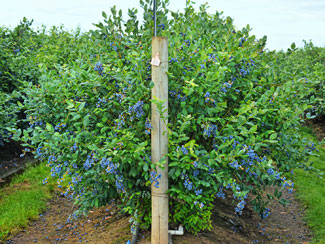Eight New Research Projects Funded
A project to study European foulbrood disease in bees is among highlights of 15 research projects funded by the Oregon Blueberry Commission’s 2021 research budget.
In all the Commission is funding eight new projects and seven ongoing projects in allocating $190,000 to research, its highest ever spending on research in a single year.
 |
T.J. Hafner, chair of the Commission’s Research Committee, noted that European foulbrood disease, caused by the bacterium Melissococcus plutonius, has become a disease of concern in recent years for beekeepers, some of whom have increased prices for hive rentals in blueberries because of it.
“It is something we’ve been hearing more and more about from our beekeepers,” Hafner said, “and it is something I think will be wise for us to get out ahead of as best we can. I was happy to see that (apiculturist) Ramesh Sagili at Oregon State put that proposal in.”
The project is expected to last two years.
Another highlight Hafner identified is research into an alternative control measure for spotted wing drosophila being led by OSU entomologist Vaughn Walton. Walton, who has researched several alternate control measures for SWD over the years, will be looking at a promising material that acts as a deterrent, or repellent, for SWD, Hafner said.
“He will be looking at ways we can utilize it in conjunction with our normal insecticide spray programs to make management of this pest more sustainable,” Hafner said.
A third highlight Hafner identified is a project led by OSU Extension Berry Specialist Bernadine Strik, who will be leading a project into use of humic acid. “David Bryla did some work a few years ago that showed that humic acids can be beneficial in improving root growth and overall biomass in young plantings,” Hafner said. “And although it is pretty much an industry standard, I don’t think anybody has looked to see the impacts of humic acids on mature blueberries.”
The projected project length is three years. Strik, who is retiring, is expected to hand off the project to her lead assistant Amanda Vance when she retires.
In another new project, Bryla, a research horticulturist for the USDA Agriculture Research Service, received funding for studying methods to increase calcium content in fruit and improve fruit quality and shelf life.
“That is a real important project, as the industry shifts more toward machine harvest for fresh,” Hafner said.
 |
Other projects new this year, include: a project involving screening new post-emergent herbicides for weed control led by OSU Assistant Professor Marcello Moretti; and a project evaluating the potential of new genetic markers for predicting blueberry fruit quality and ripening led by Michael Hardigan of the USDA ARS.
Among ongoing projects funded this year are: a look at aerial gall disease of blueberries led by ARS plant pathologist Virginia Stockwell; and two projects led by Bryla, one looking at comprehensive management strategies for use of biostimulants, which is in year three, and a second involving improving practices for assessing plant water needs, which is in its second year.
Also Included in the ongoing projects is research into machine harvest for specialized process and fresh market blueberries, which is led by Strik, and the cooperative breeding project that the Commission has backed now for 30 years, as well as offshoots of that aimed at developing cultivars with emphasis on heat tolerance and processing quality.